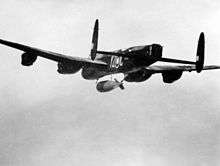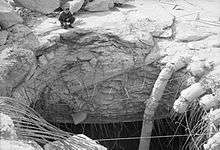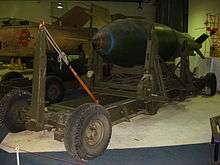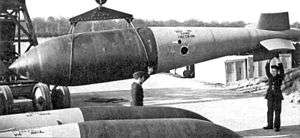Grand Slam (bomb)
| Grand Slam | |
|---|---|
|
A Grand Slam bomb being handled at RAF Woodhall Spa | |
| Type | Earthquake bomb |
| Place of origin | United Kingdom |
| Service history | |
| In service | 1945 |
| Used by | Royal Air Force |
| Wars | World War II |
| Production history | |
| Designer | Barnes Wallis |
| Designed | 1943 |
| Manufacturer |
Vickers, Sheffield Clyde Alloy/Steel Company of Scotland, Blochairn, Glasgow |
| Produced | 1944–45 |
| Number built | 42 used, 99 built by Clyde Alloy plus others from the Smith Corporation of America[1] |
| Variants | M110 (T-14) 22,000-lb GP Bomb (United States)[2] |
| Specifications | |
| Weight | 22,000 lb (10,000 kg) |
| Length | 26 ft 6 in (8.08 m) |
| length | Tail 13 ft 6 in (4.11 m) |
| Diameter | 3 ft 10 in (1.17 m) |
|
| |
| Filling | Torpex D1 |
| Filling weight | 4,144 kg (9,136 lb) |
Detonation mechanism | penetration: 40 m (130 ft) (earth)[3] 2–6 m (20 ft) (concrete)[3][4] |
| Blast yield | 6.5 tons TNT equivalent [lower-alpha 1] |
The Grand Slam was a 22,000 lb (10,000 kg) earthquake bomb used by RAF Bomber Command against strategic targets during the Second World War. It was the most powerful non-atomic bomb used in the war.
Known officially as the Bomb, Medium Capacity, 22,000 lb, it was a scaled-up version of the Tallboy bomb and closer to the original size that the bombs' inventor, Barnes Wallis, had envisaged when he first developed his earthquake bomb idea. It was also nicknamed "Ten ton Tess".[5]
Development
When the success [of the Tallboy bomb] was proved, Wallis designed a yet more powerful weapon… This 22,000 lb. bomb did not reach us before the spring of 1945, when we used it with great effect against viaducts or railways leading to the Ruhr and also against several U-boat shelters. If it had been necessary, it would have been used against underground factories, and preparations for attacking some of these were well advanced when the war ended.
On 18 July 1943, work started on a larger version of the Tallboy bomb, which became the Grand Slam.[2] As with the original Tallboy, the Grand Slam's fins generated a stabilizing spin[7] and the bomb had a thicker case than a conventional bomb, which allowed deeper penetration. After the hot molten Torpex was poured into the casing, the explosive took a month to cool and set. Like the Tallboy, because of the low rate of production and consequent high value of each bomb, aircrews were told to land with their unused bombs on board rather than jettison them into the sea if a sortie was aborted.[8]
After release from the Avro Lancaster B.Mk 1 (Special) bomber,[2] the Grand Slam would reach near-supersonic speed, approaching 1,049 ft/s (320 m/s), 715 mph (1150 km/h). When it hit, it would penetrate deep underground before detonating. The resulting explosion could cause the formation of a camouflet[9] (cavern) and shift the ground to undermine a target's foundation.
Unlike Tallboy, Grand Slam was originally designed to penetrate concrete roofs.[10] Consequently, it was more effective against hardened targets than any existing bomb.
The first Grand Slam was tested at the Ashley Range in the New Forest, on 13 March 1945.[11][12]
Grand Slam combat operations



By the end of the war, 42 Grand Slams had been dropped on active service.[13]
- Bielefeld, 14 March 1945
- The No. 617 Squadron RAF Avro Lancaster of Squadron Leader CC Calder dropped the first Grand Slam bomb from 11,965 ft (3,647 m) on the Schildesche viaduct.[14] More than 100 yards of the Bielefeld viaduct collapsed through the earthquake bomb effect[15] of the Grand Slam and Tallboy bombs of No. 617 Squadron. No aircraft were lost.[16]
- Arnsberg, 15 March 1945
- Two aircraft of No. 617 Squadron RAF each carried a Grand Slam and 14 aircraft of No. 9 Squadron RAF carried Tallboy bombs to attack the railway viaduct in poor weather. One Grand Slam and 10 Tallboys were dropped, while one of the Lancasters was forced to bring its bomb back. The viaduct was not cut and no aircraft were lost.[16][17][18]
- Arnsberg, 19 March 1945
- 19 Lancasters of No. 617 Squadron, six carrying Grand Slams, the remainder Tallboys, attacked the railway viaduct at Arnsberg. All Grand Slams were dropped and blew a 40-foot (12 m) gap in the viaduct.[16][19] The standing structure was severely damaged.[18]
- Arbergen, 21 March 1945
- 20 Lancasters of No. 617 Squadron, two carrying Grand Slams, the remainder Tallboys, attacked the railway bridge at Arbergen. The Grand Slams landed off target due to heavy flak and aiming problems; 2 Tallboy hits caused sufficient damage to the approaches to the bridge to put it out of use. One 617 Lancaster was lost.[20]
- Nienburg, 22 March 1945
- 20 Lancasters of No. 617 Squadron, six carrying Grand Slams, the remainder Tallboys, attacked the railway bridge at Nienburg, between Bremen and Hanover. 5 Grand Slams made direct hits and the bridge was destroyed. Another 5 bombs were brought home by the squadron.[18][21]
- Bremen, 23 March 1945
- 20 Lancasters of No. 617 Squadron, six carrying Grand Slams, the remainder Tallboys, attacked a railway bridge near Bremen. The Grand Slams appear to have landed too far from the target, which was brought down by a Tallboy.[22] Author Jon Lake claims instead that two Grand Slams struck the bridge.[18]
- Farge, 27 March 1945
- 20 Lancasters of No. 617 Squadron attacked the Valentin submarine pens,[4] a huge, nearly-ready structure with a concrete roof up to 23 ft (7.2 m) thick. Two Grand Slam bombs penetrated in parts of the pen with a 14 ft 5 inches (4.5 m) thick roof,[4][23] which rendered the shelter unusable. No aircraft were lost.[16][24]
- Hamburg, 9 April 1945
- 17 aircraft of No. 617 Squadron, two with Grand Slams and the remainder with Tallboy bombs successfully attacked the U-boat shelters. The Grand Slams appear to have missed, but six Tallboy hits caused considerable damage. No aircraft were lost.[25][26]
- Heligoland, 19 April 1945
- 20 aircraft of No. 617 Squadron, six with Grand Slams and the remainder with Tallboy bombs, along with 16 aircraft from No. 9 Squadron, attacked coastal gun-batteries. No aircraft were lost.[25][27]
Post–war operations
Beginning in March 1946, Project Ruby was a joint, Anglo–American project to investigate the use of penetration bombs against heavily protected, concrete targets. The target selected was the Valentin submarine pens, that had been rendered unusable and abandoned since 617 Squadron's attack on 27 March 1945. Grand Slams were carried by Lancasters from No. 15 Squadron RAF and US Boeing B-29 Superfortress. Around 140 sorties were flown, testing a range of different bombs.[3]
Survivors

Five complete Grand Slam bombs are preserved and displayed in the United Kingdom at the RAF Museum, London; Brooklands Museum; RAF Lossiemouth; Dumfries and Galloway Aviation Museum and the Battle of Britain Memorial Flight Visitors' Centre at RAF Coningsby. Main portions of these bombs, without their lightweight tails, can be seen at the Kelham Island Museum in Sheffield and Yorkshire Air Museum at Elvington.
A T-14 bomb (an American-made variant of the Grand Slam) is displayed at the Air Force Armament Museum in the United States.
See also
Notes
- ↑ Torpex is 50% more powerful than TNT. Truman described the Little boy bomb (yield > 13 kilotons) against Hiroshima in terms of the Grand Slam: "...more than two thousand times the blast power of the British Grand Slam" (Truman 2008).
- ↑ Flower 2004, appendix 4 "bombs":
- Schildesche viaduct, Bielefeld: 1
- Arnsberg viaduct: 7
- Arbergen bridge: 2
- Nienburg viaduct: 5
- Bremen bridge: 5+1 jettisoned
- Farge U-boat shelter: 12+1 jettisoned
- HamburgU-boat shelter: 2
- Heligoland coastal batteries: 6
- plus 1 tested at Ashley Walk bombing range in the New Forest and an unknown number used in post war trials
- 1 2 3 (Godwin 2007)
- 1 2 3 Flight staff 1946.
- 1 2 3 Grube 2006.
- ↑ MAP Exhibition Flight 21 June 1945 p688
- ↑ Harris 2005, p. 252.
- ↑ Constable 2008.
- ↑ Flower 2004, p. 335.
- ↑ Kharin, Kuzmina & Danilova 1972.
- ↑ Flower 2004, p. 375.
- ↑ "Ashly Range". New Forest National Park. Retrieved 23 January 2014.
- ↑ Hugo Gye (23 January 2014). "Revealed: The birthplace of Barnes Wallis's other top secret weapon". Daily Mail. Retrieved 23 January 2014.
- ↑ Flower 2004, Appendix 4.
- ↑ Flower 2004, p. 331.
- ↑ A camouflet from the Grand Slam caused the Bielefeld railway viaduct damage.
- 1 2 3 4 RAF staff 2005, March
- ↑ Flower 2004, pp. 332-334.
- 1 2 3 4 Lake 2002, p. 62.
- ↑ Flower 2004, pp. 334-40.
- ↑ Flower 2004, pp. 340-42.
- ↑ Flower 2004, pp. 342-43.
- ↑ Flower 2004, pp. 344-47.
- ↑ RAF staff 2005a, Grand Slams.
- ↑ Flower 2004, pp. 348-52.
- 1 2 RAF staff 2005, April
- ↑ Flower 2004, pp. 355-58.
- ↑ Flower 2004, pp. 362-64.
References
- AAA anonymous (2004). "The 'gate guards' at RAF Scampton's main gate in about 1958". Australian Armourers Association. Archived from the original on 18 September 2009. Retrieved January 2012. Check date values in:
|access-date=(help); External link in|publisher=(help) - Constable, Miles (21 April 2008). "English Bombs of WWII". Canadian Aces. constable.ca. Archived from the original on 17 September 2012. Retrieved July 2013. Check date values in:
|access-date=(help) - "Bombs Versus Concrete". Flight. XLIX (1953): 537–541. 30 May 1946.
- Flower, Stephen (2004). Barnes Wallis’ Bombs. Strood: Tempus Publishing Ltd. ISBN 0-7524-2987-6.. Researched from the original records and interviews with those involved with the development and use of the bombs.
- Godwin, John (2007). "The Man-Made Earthquake". members.aol.com. Archived from the original on 30 December 2007. Retrieved February 2008. Check date values in:
|access-date=(help) - Grube, Christel (28 February 2006). "Submarine-Valentin, Bremen-Farge". Interessengemeinschaft für historische Militär-, Industrie- und Verkehrsbauten (in German). Retrieved February 2008. Check date values in:
|access-date=(help) - Harris, Sir Arthur (2005) [1947]. Bomber Offensive. Pen & Sword Military Classics. p. 252. ISBN 1-84415-210-3.
- Kharin, D. A.; Kuzmina, I. V.; Danilova, T. I. (22 September 1972). "Ground Vibrations during Camouflet Blasts". Foreign Technology Division, Wright-Patterson AFB, Ohio. Archived from the original on 21 February 2009. Retrieved February 2008. Check date values in:
|access-date=(help) - Lake, Jon (2002). Lancaster Squadrons 1944-45. Osprey Publishing. p. 62. ISBN 1-84176-433-7.
- RAF staff (6 April 2005). "Bomber Command Campaign Diary". Bomber Command 60th Anniversary. Archived from the original on 6 July 2007. March and April
- RAF staff (6 April 2005a). "Grand Slam Raids". Archived from the original on 6 July 2007.
- Truman, Harry S. (then U.S. President) (2008) [1945]. "White House Press Release on Hiroshima:Statement by the President of the United States". atomicarchive.com. Retrieved 2008-02-25.
External links
| Wikimedia Commons has media related to Grand Slam bomb. |
- Wallis's Bombs - Big & Bouncy - www.sirbarneswallis.com
- A picture of a Lancaster carrying a Grand Slam
- Movietone News "Ten Tonner" - video of a Grand Slam being dropped on the Bielefeld Viaduct on youtube.com
- The hole left in the roof by a Grand Slam at the Farge U-boat pen
